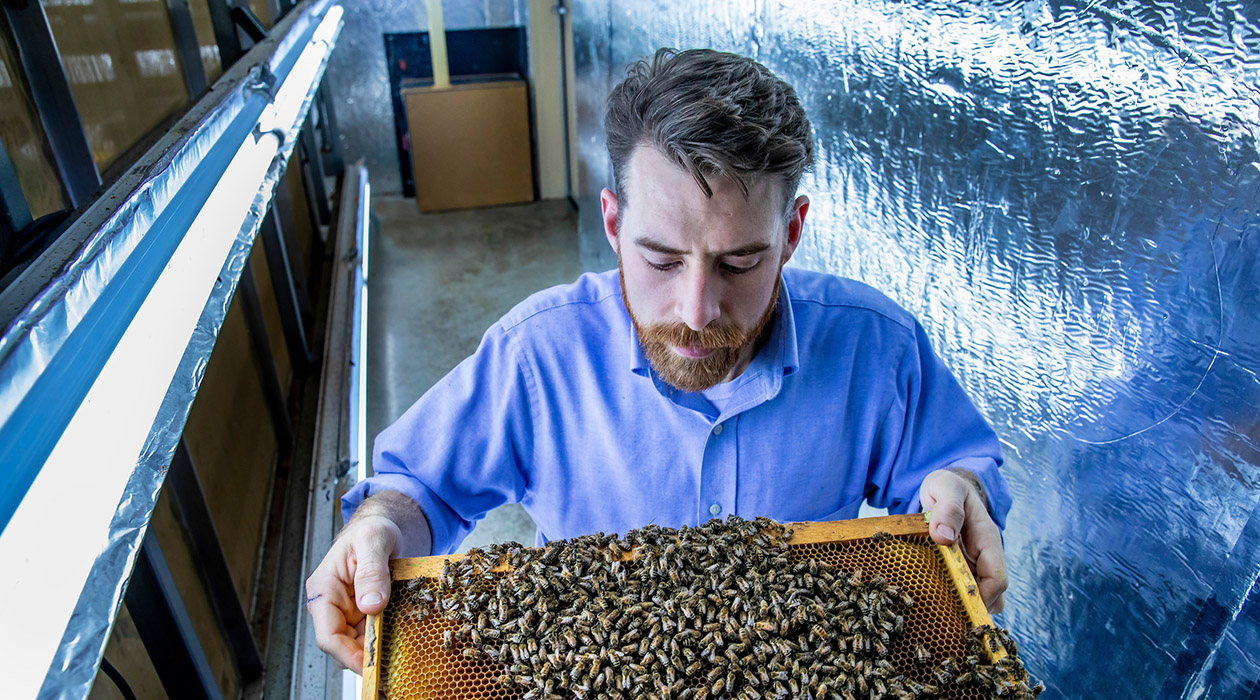Are honey bees, wild bees still in trouble?

Illinois entomology professor Adam Dolezal studies the factors affecting native bees and honey bee health. / Fred Zwicky
A new report reveals that U.S. beekeepers lost roughly half of the honey bees they managed last year. University of Illinois Urbana-Champaign entomology professor Adam Dolezal (IGOH), who studies how environmental stressors affect honey bees and wild bees, spoke to News Bureau life sciences editor Diana Yates about the current status of bees in the U.S.
Honey bee populations have been faltering since at least 2006. Why can’t scientists and the beekeeping community address and solve whatever is causing the massive die-offs?
While scientists and beekeepers have made progress understanding what causes problems in bee health, finding solutions is more difficult because the problems are complex, variable, and interact with each other. For example, one of the major issues in bee health is nutrition – a biological issue. But this problem is related to changes in land use, with areas that once supported honey bee foraging being converted more and more into crops that don’t really benefit bees. This is an economic/policy issue.
The nutrition problem interacts with pesticide exposure and pathogen stress, which both have their own independent complexities. Climate change also means much more variable and volatile weather during the seasons when bees are active and over the winter. These factors affect bees and beekeeping in ways we don’t yet fully understand. So, while many are working to improve bee health in many small ways, there is no single simple problem so there cant be one single simple solution.
What factors are most important to the survival of honey bees?
Honey bees are really flexible and resilient animals, and beekeepers are smart and resourceful people. This is why we see honey bees – wild and managed – across the globe. One major drawback of being so easily kept and moved by beekeepers is that bees come into contact with more pests and pathogens, which can rapidly move through a population.
Varroa mites are the major pest of honey bees, and they transmit viruses – much like mosquitoes or ticks transmit diseases to humans. Over the last few decades, these viruses seem to become more and more damaging, with fewer mites causing more harm than before.
Honey bees are also used extensively to pollinate the crops we eat. This often puts them at risk of exposure to agricultural chemicals that can be harmful to them. And of course, like all animals, they need proper nutrition; without it, they become more susceptible to diseases and pesticides.
Are wild bees also suffering the same dramatic losses? If so, why?
Beekeepers were able to notice and call attention to their losses early on because they were keeping a close eye on their bees. It is a lot harder to keep tabs on the more than 4,000 native bee species in the U.S., and we know much less about individual species.
We do know that wild bees are also facing habitat loss, pesticide exposure and disease pressure that puts them at risk, too. If anything, wild or native bee losses may be more dramatic than those seen in honey bees. While the deaths of 50% of honey bee colonies may seem staggering, beekeepers can and do manage these losses to keep our honey bee population stable and effective. But our native bees are precious wildlife that can’t be easily managed.
What potential remedies are available now?
Keeping honey bees fed and disease-free is as difficult as ever, but researchers continue to develop new supplemental feeds for honey bees and treatments to fight Varroa mites and other pests.
Researchers also try to improve honey bee colony survival through the development of hive-monitoring technologies or indoor facilities for overwintering large numbers of colonies. More than 100 years ago, beekeepers stored their honey bees indoors in winter, and there has been a rebirth of modern indoor honey bee cold storage, which uses much more sophisticated cooling and monitoring systems to keep bees at optimal conditions throughout this stressful period. While still in development, there is a lot of potential for this approach to alleviate some of our winter loss problems.
Other remedies will likely require more systemic solutions. For example, one of the major ways that non-crop habitat is supported in agricultural areas is through the U.S. Conservation Reserve Program, which supports a variety of conservation practices on farmlands. At present, however, CRP acreage is near an all-time low. If we want to support pollinators and other beneficial wildlife, we need to support both publicly and privately funded programs that help provide habitat across the country.
What obstacles are hindering efforts to address the problem?
While I think there has been progress in improving bee health, the underlying problems are really big. Mitigating honey bee pests and parasites is hard; it is challenging to find treatments that kill the pest without harming bees. Modern beekeeping also moves honey bee colonies extensively throughout the U.S., so any new pests or diseases get transported across the continent within a year. Not all beekeepers agree about treatment approaches, which also leads to parasite spread between beekeeping operations.
Poor nutrition and pesticide exposure occur variably throughout the U.S., but are often expected as part of the bee pollination system. Dealing with these issues is more difficult, as the drivers behind land use and pesticide use are bigger economic and policy issues – it is rarely in one group’s or one person’s power to overhaul land-use practices across a large territory all at once.
